Bad Bunny Conquered the World. Now What?

Backstage, minutes before Bad Bunny’s headlining set at Coa-chella, everyone seems to be running on pure adrenaline. A group of dancers are climbing a set of stairs toward their marks when a security guard stops a wardrobe designer in their midst and refuses to let him pass. “He’s the designer!” one woman shrieks, her voice crackling with the anxiety of countless things that could go wrong.
A gate flings open, and Kylie and Kendall Jenner pass through the backstage area, leaving me so surprised that I wheel around and almost hit Kylie with my backpack. Nearby, a troop of fans break into sprints, trying to get into a private area just in front of the stage that’s rapidly filling up with celebrities from all over the world. Eventually, the Jenners; Blackpink’s Jennie, Rosé, and Jisoo; Mexican singer Peso Pluma; and Hailey and Justin Bieber all stand there to watch Bad Bunny make history in real time.
More from Rolling Stone
The crowd radiates a chaotic, uncontainable energy, understanding that there will be a precise before and after this moment. Bad Bunny is about to become the first Latino solo act and first Spanish-language artist to headline Coachella in the festival’s 30-year history.
Screens flicker. As the audience roars a few decibels louder in anticipation, Benito Antonio Martínez Ocasio is standing onstage in the dark, a mantra running through his head: Thank you, God, thank you, life, for letting me do this. It’s one of the only private moments he lets himself have during the performance — if he gets sidetracked by any thought, he tends to forget his lyrics, and this event is too big for distractions.
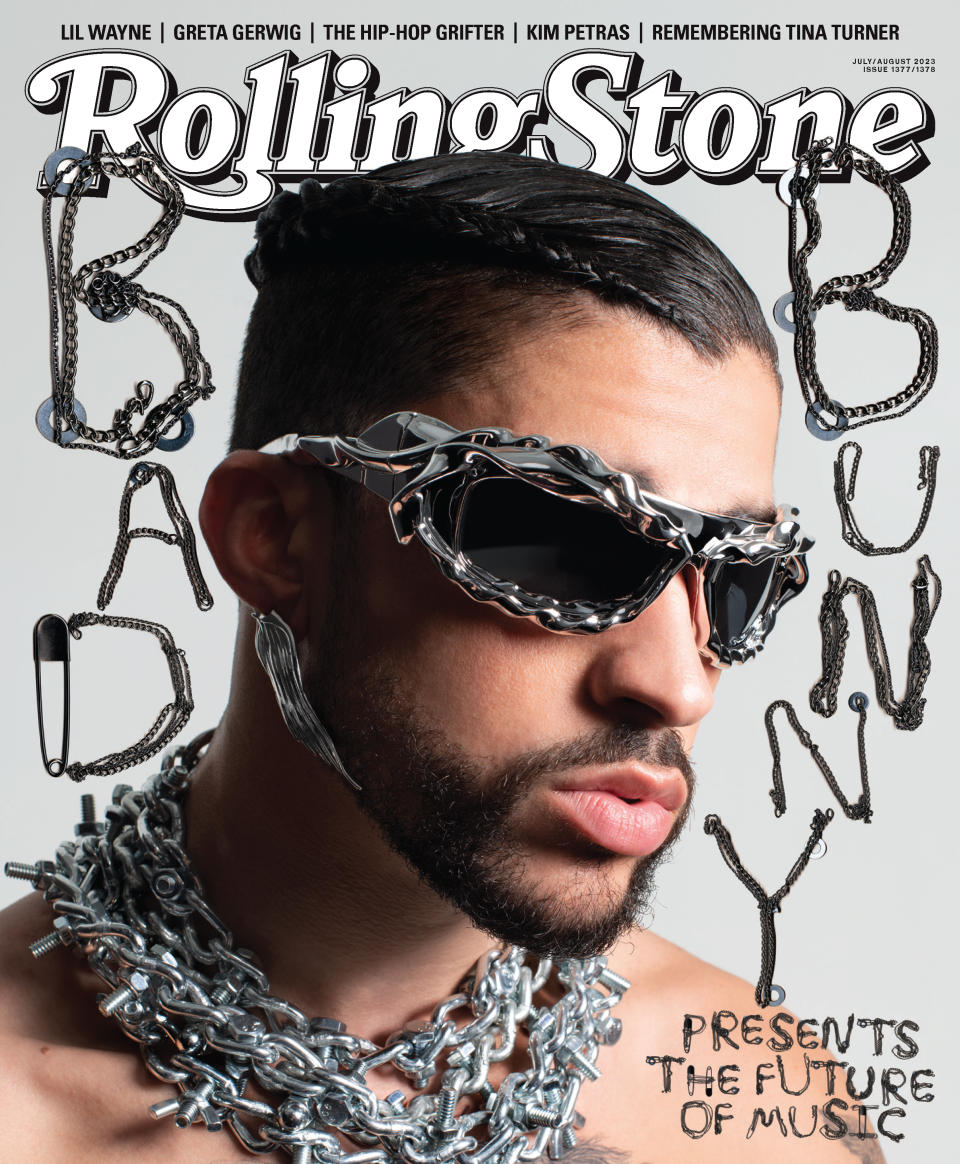
Martínez dives into his set, blasting through hits from Un Verano Sin Ti, his world--conquering album from last year. He packs in detailed video tributes to salsa and reggaeton, recounting the music’s history and honoring artists from previous generations. “There were a lot of people way before me who did huge things,” he tells me later. “Sometimes people forget or, who knows, maybe gringos weren’t paying as much attention. But now that the focus is on us, I -wanted to make it clear there’s been a long road before me.” Partway through his set, he brings out reggaeton pioneers Jowell Y Randy and ?engo Flow for “Safaera,” the voltaic, constantly morphing perreo mini mix, made up of old-school beat flips and samples that capture the spirit of Puerto Rico’s marquesina parties.
And then comes an unexpected hurdle. Martínez wanted to surprise the audience with a special guest — someone he’d never collaborated with, someone no one would ever guess. In the final weeks of rehearsals, he made a call to Post Malone, who was down to help out, even though the two had never met in person. Malone pops up partway through the show and joins Martínez for acoustic versions of “Yonaguni’’ and “La Canción.” Unfortunately, as Malone begins strumming, the mic on his guitar cuts out, and the two of them stand there, fumbling with a cord for a few excruciating minutes. “I was worried about him,” Martínez says later. “When I saw his face, it was like, ‘This can’t be happening.’ So that’s when I took the lead and was like, ‘Don’t worry, don’t worry.’ ” Martínez gets the crowd to sing along so he can finish the tracks a -cappella, even as Malone keeps plucking away on a silent guitar. “The most important reaction to have was not to lose my head,” Martínez recalls. He eventually peels off on a jet ski, part of the elaborate stage design, and sings a few tracks with -Jhayco while Malone stays right there, dancing and vibing out until the show is over.
In the end, the two-hour set was unprecedented and imperfect, historic and human. As soon as it was over, Martínez hopped in a car and headed back to the house in Palm Springs he rented during the festival. He took a shower. He ate a bowl of cereal. And within 15 minutes, he fell fast asleep. “I laid down and went to bed, tranquilito, tranquilito.” Calmly, calmly, just another day in the life of a global megastar.
DO YOU THINK Bad Bunny took time off after Coachella? Of course he didn’t. Five days after the performance, he’s trekking out to Lucerne Valley — the dry, cracked terrain that’s served as a backdrop for Westerns like Stagecoach and horror films like The Hills Have Eyes — to shoot the video for his newest song, “Where She Goes.” The moody, lovelorn track tells the story of a one-night stand over a breakneck Jersey--club beat. The title is meant to be a tease: “I like to make people wonder and make them think I’m releasing a song in English because people are jodiendo, like atatatata,” he says, mimicking the nonstop chatter he’s been hearing on social media. He wrote it in Los Angeles sometime around February, after revisiting a track his producer MAG sent him. There’s speculation online that it’s about his rumored relationship with Kendall Jenner, but when I ask what inspired it, he only says, “cosas de la vida” — “things in life.”
Before the shoot, a text went out to the crew, urging everyone to wear face masks because of intense desert winds. Stillz, Martínez’s frequent director, helped come up with the video concept, which involves Martínez speeding through the desert in a vintage Rolls-Royce as a series of visions — a woman with angel wings, wild horses kicking up dust — flash by.
Martínez rolls up to the set and bounces directly into his trailer to get ready for the first shot. As he changes in the back, a few guys from his team — including his manager Noah Assad and creative consultant Janthony Oliveras — are hanging around a small kitchen, watching Los Cangrejeros de Santurce, a Puerto Rican basketball team Martínez and Assad co-own, play Los Vaqueros de Bayamón. By the time Martínez emerges in navy-blue pants and a studded jacket, a heated discussion about soda has erupted: One side of the room argues that it’s always -better in a can, the other defends the merits of fountain drinks. Martínez steps in, settling the debate: “A can. There’s no comparison,” he says. “The only thing that can stand up to it — because of the nostalgia factor — is a fountain drink you get at the movies.”
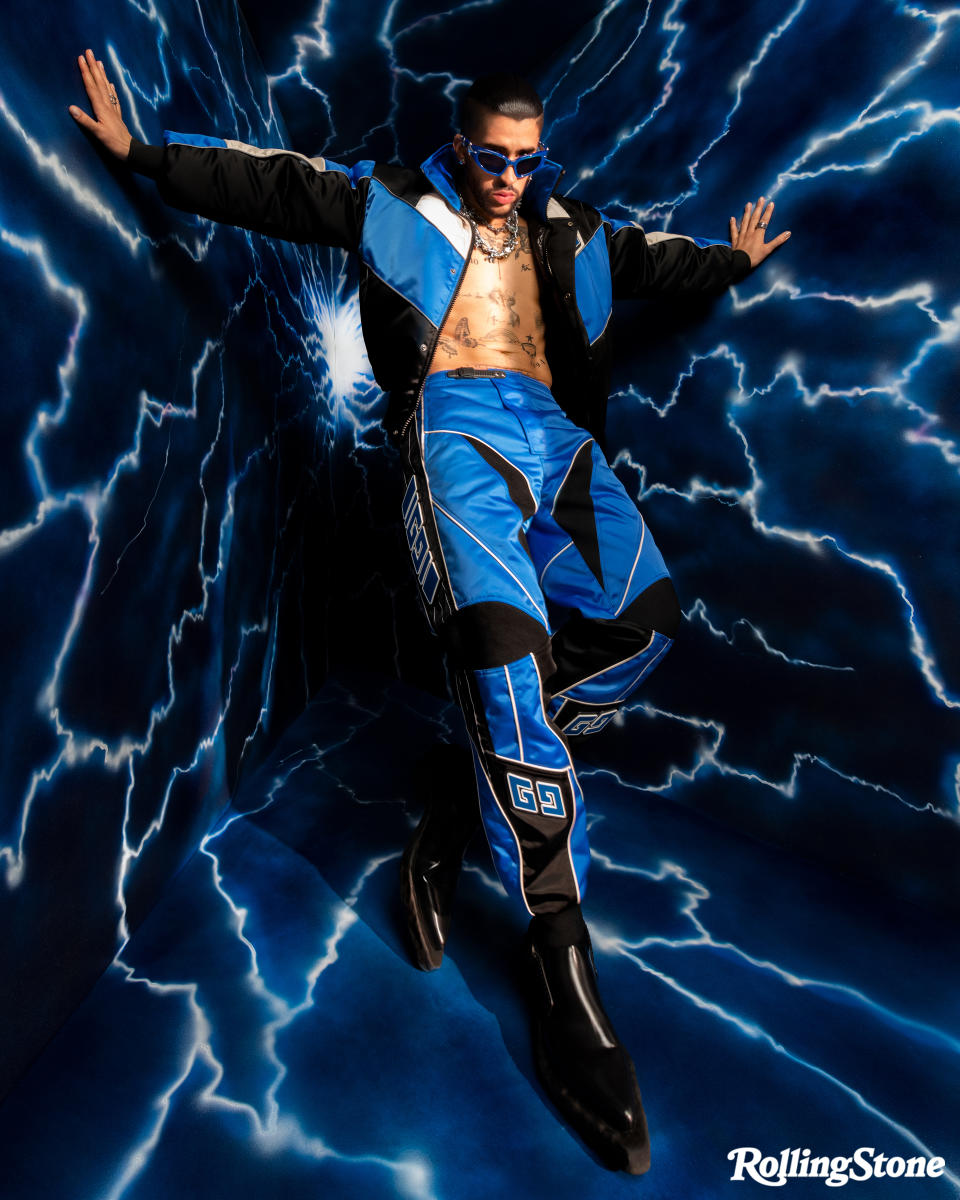
It feels like he’s talking about a remnant of his old life, when he was a college kid bagging groceries at a supermarket and making beats in his room — worlds away from where he’s at now. Over the past year, he’s reached a new stratosphere of stardom: Un Verano Sin Ti became the biggest album in the world in 2022, according to the IFPI (and the most-streamed in the U.S.), beating out Beyoncé and Taylor Swift while making history as the first Spanish-language LP to receive a Grammy nomination for Album of the Year. He had a memorable cameo in Bullet Train alongside Brad Pitt. He was Spotify’s most-streamed artist for the third year in a row and broke the world record for the highest-grossing tour in a calendar year. He’s done all of this fearlessly and without compromise: He’s refused to make concessions to the Anglo market, challenged gender norms with his sense of style, and lifted up Puerto Rican and other Latino communities in the process. His music is unabashedly political but also stylistically unpredictable, delivered in a one-of-a-kind baritone that’s made him the people’s icon.
All of it has culminated in a level of fame that means he’s virtually everywhere — even at Walmart, where, just the other day, one of his team members found an entire unauthorized Bad Bunny magazine. There’s a copy of it sitting in front of me, so I flip through it and find a quiz inside called the Rabbit Test. I hand it to him and joke that he should take it. Some stuff, like what profession his mom and dad had in Puerto Rico (a teacher and a truck driver), is easy. But he can’t remember which of his songs first cracked the Hot 100 (kind of a trick question — it was Becky G’s 2017 hit “Mayores,” which he’s featured on) and whose tour record he broke in 2022 (Ed Sheeran). In the end, not even Martínez gets a perfect Rabbit score.
In fairness, his whirlwind career is hard to keep up with. In early 2022, he made his way through North American arenas for El último Tour Del Mundo. Just weeks after his final show, he dropped Un Verano Sin Ti and launched the World’s Hottest Tour, which took him to some of the biggest stadiums across the globe. He spent the next few months making headlines for bringing out surprise guests like Romeo Santos and Cardi B, and for selling out show after show.
His first 2023 performance was a Grammy--opening salvo that honored his Caribbean roots; a screenshot of the broadcast’s closed captioning describing him as “singing in non--English” went viral. But — and this is where the global ubiquity thing gets complicated — other moments this year went viral, too: an infamous video of him chucking a fan’s phone after she shoved into him for a selfie, paparazzi shots of him with Jenner, fans getting frustrated with his quotes about colorism and his song “El Apagon” (more on all of that in a moment). In between, there were lawsuits, including one filed by an ex--girlfriend alleging unauthorized use of her voice on two songs, and a whole lot of opinions online.
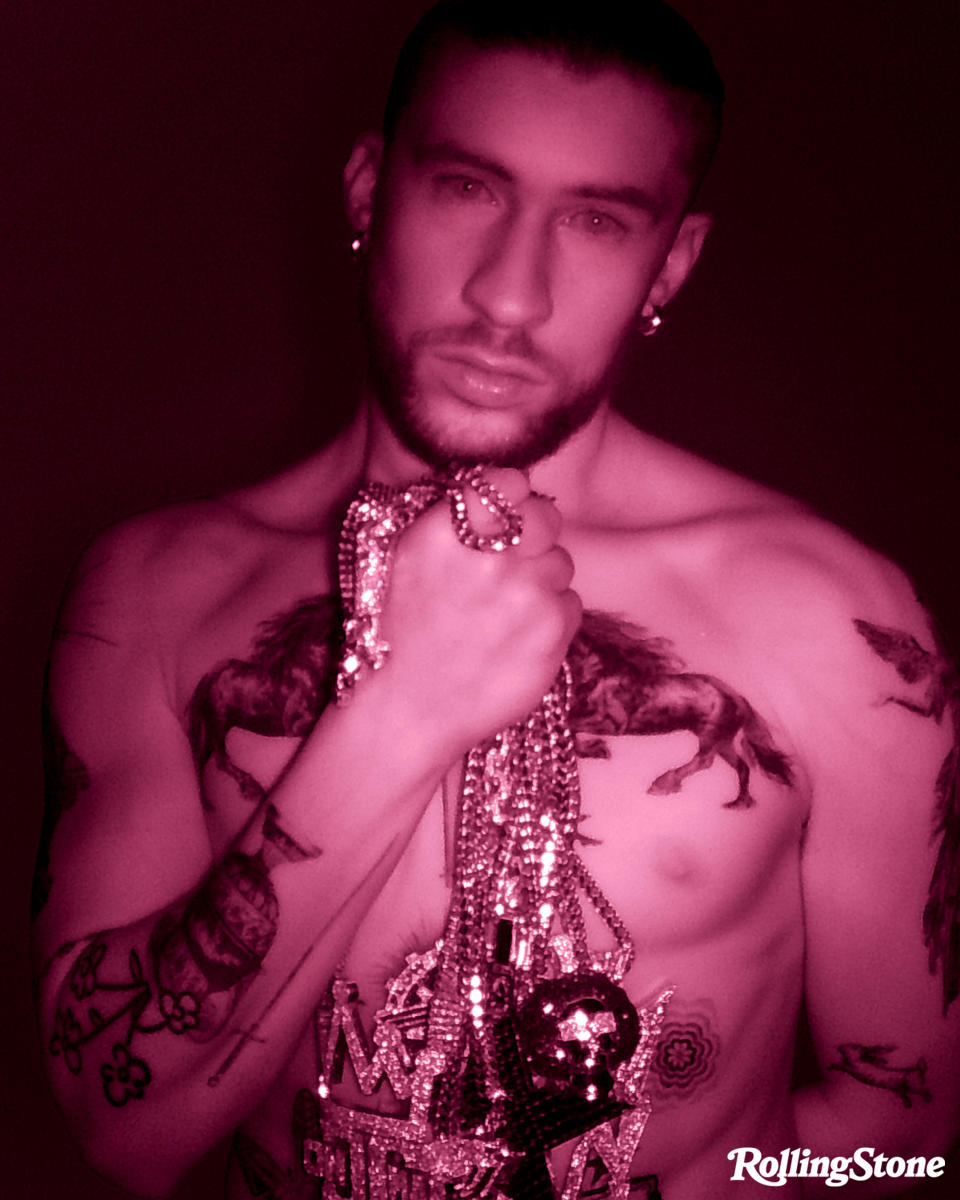
In person, Martínez is taller than I imagined, but he looks younger than 29.?? Though he’s been training for an upcoming appearance at WWE’s Backlash event, he’s more lanky than he is bulky, his legs stretched out under a small table in the trailer. His enormous brown eyes stay steady and fixed as he delivers his thoughts. When he gets riled up, he speaks in quick, animated bursts, especially as he’s outlining the complexities of a wild 2023.
He doesn’t mind the work; he calls his time on tour intense but also wonderful, a chance to connect with fans. Still, at the end of 2022, he’d been envisioning a time when he’d get to turn inward and focus on himself for a bit. “That’s what I’ve been trying to do without caring about the obstacles, because it’s … cabron,” he says, employing a word that in this context can only be translated as “fucking hard.” He trails off for a second. “I love the world, but I also hate the world,” he declares finally. I look at him surprised, but he’s laughing, a slightly mischievous glint in his eye. “That should be the cover: ‘I love the world but sometimes I hate it.’ ”
There’s a kind of levity to how he says it. He’s finding the humor in all of this, smiling slyly and refusing to take things too seriously. But he’s also being honest: “Check this,” he continues. “Before 2022 was over, I said in an interview, ‘2023 is going to be for me, to rest, to work on my physical health, on my mental health, to have my space, to enjoy, to be happy.’ And then 2023 starts with cabroneria.”
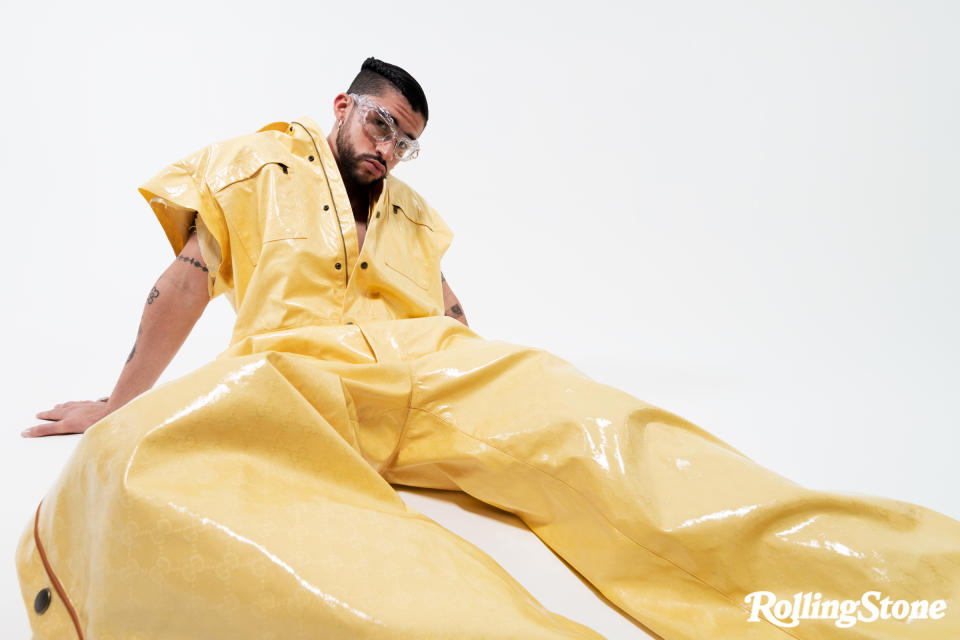
How to translate that one? Silliness? Fuckery? He’s talking specifically about the social media uproar that followed the cellphone thing, the grim irony of wishing for a quiet year and getting chaos. But he also refuses to let that kind of thing get in his way. “At the end of the day, I don’t care what people think,” he says. This is, after all, the guy who has made an entire brand out of doing exactly what he wants — and his current goal is to keep doing that, even through the demands of hyper-stardom and a career that keeps expanding at warp speed.
A few minutes later, he heads out into the desert to shoot. He knew the sandstorms were coming, but didn’t anticipate how strong they’d be. He returns to the trailer, wind-whipped and flushed, rubbing together red, chapped hands, but then he’s on his way again. Before I head home, I make out his figure in the distance, standing there battling the elements.
In January, Martinez vacationed in the Dominican Republic. He was walking down a street with friends when fans started rushing over to say hi. “People were recording,” he says. “I love going to D.R., so I was waving to everyone, like, ‘Que lo que!’ ” Suddenly, a woman jumped in front of him for a selfie. “That person got right on me, leaned directly on my body,” he says. His immediate instinct was to toss the phone.
Did he feel bad about it? “The next day! The next day, the next day,” he says, throwing his hands in the air. But he felt his personal space had been invaded, and he adds that he didn’t toss it into the ocean, as some outlets -reported. “Bro, that cellphone didn’t break. It exists. It bothers me that people haven’t said that. I didn’t throw that phone into the water. I threw it into some bushes.” He claims the woman picked it up right where it landed. “She has it. She should upload the video,” he says, chuckling dryly.
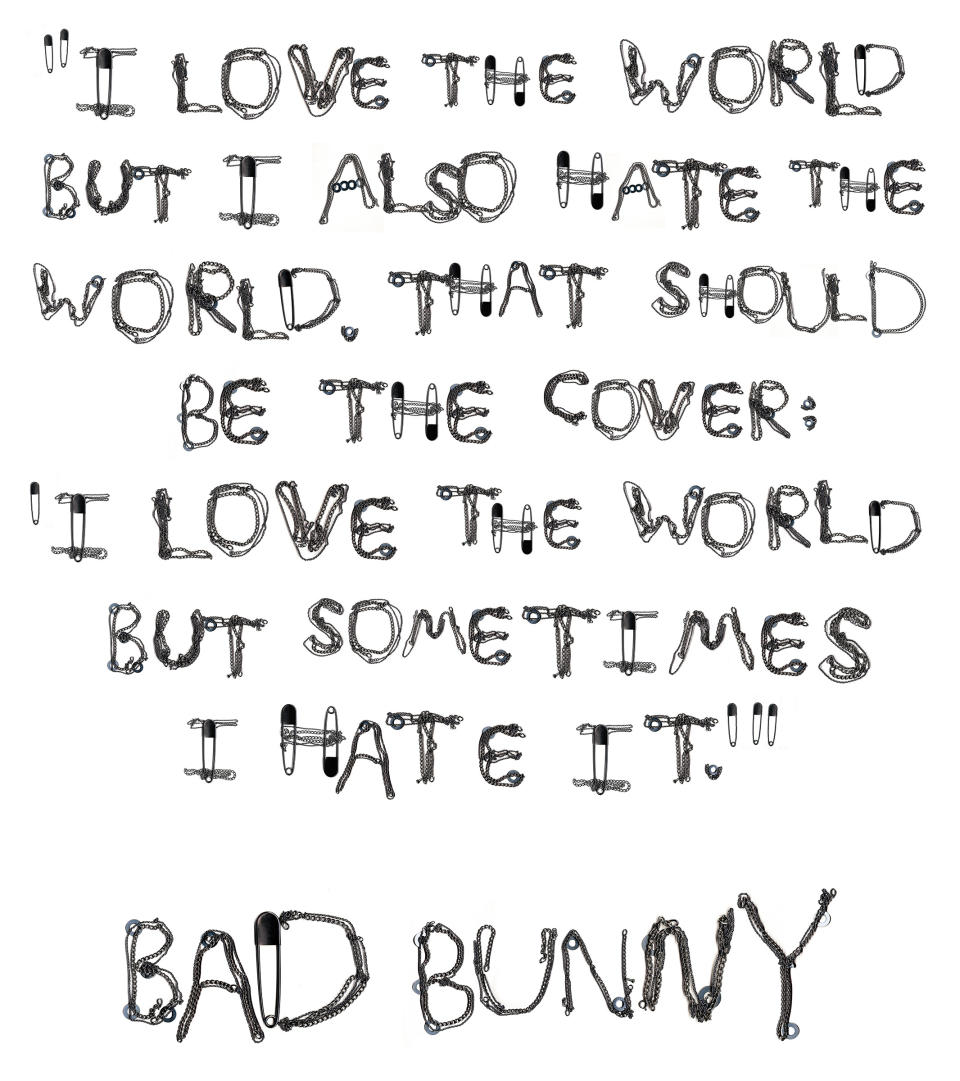
Arguments about his behavior raged online; some defended him, while others — including a few reggaeton artists — thought lobbing a fan’s personal property went too far. Martínez locked down his social media and retreated to a mansion he reportedly bought for $8.8 million in the Hollywood Hills.
After announcing he would be part of the Backlash wrestling event, which was held in Puerto Rico in May, he started working with a WWE trainer. He caught up on TV shows and movies: He’s been rewatching Game of Thrones because Oliveras has never seen it, and he’s worked through Apple TV+’s Shrinking, starring Jason Segel as a grieving therapist who takes an active role in his patients’ lives.
Martínez has also gotten into vinyl from the Seventies, a period he says has been inspiring his music. He was browsing a record store in Santa Monica when he found an album by the Puerto Rican artist José Feliciano, sending him down a rabbit hole into the singer-songwriter’s 60-year career. Yes, there’s the Christmas classic “Feliz Navidad,” but there are also 19 Grammy nominations, 56 albums, and his stripped-down, folksy take on “The Star-Spangled Banner” in 1968 that was met with such outrage that racists began calling for Feliciano to be deported, even though -Puerto Ricans are U.S. citizens.
“It struck me that I think a lot of younger people don’t know how big he was,” Martínez explains. “People are like, ‘Oh, Bad Bunny is breaking ground with gringos!’ No, papi — José -Feliciano was breaking ground with gringos since the Seventies, you hear me? He was doing worldwide tours, he was in London, singing in -English, singing to Anglophone audiences.”
In some ways, Feliciano’s story reflects an ahistorical view of Latin music -perpetuated by Anglo media: the idea that Latin artists exist in boom cycles, only relevant when they’re deemed popular by Anglo audiences. Latin music is growing rapidly — last year it generated more than $1 billion in revenue in the U.S. alone, a 23.8 percent increase from the previous year (a lot of that was driven by Martínez). But focusing on sales numbers and commercial viability can flatten dec-ades of art and erase towering Latin figures who’ve been an integral part of American musical history.
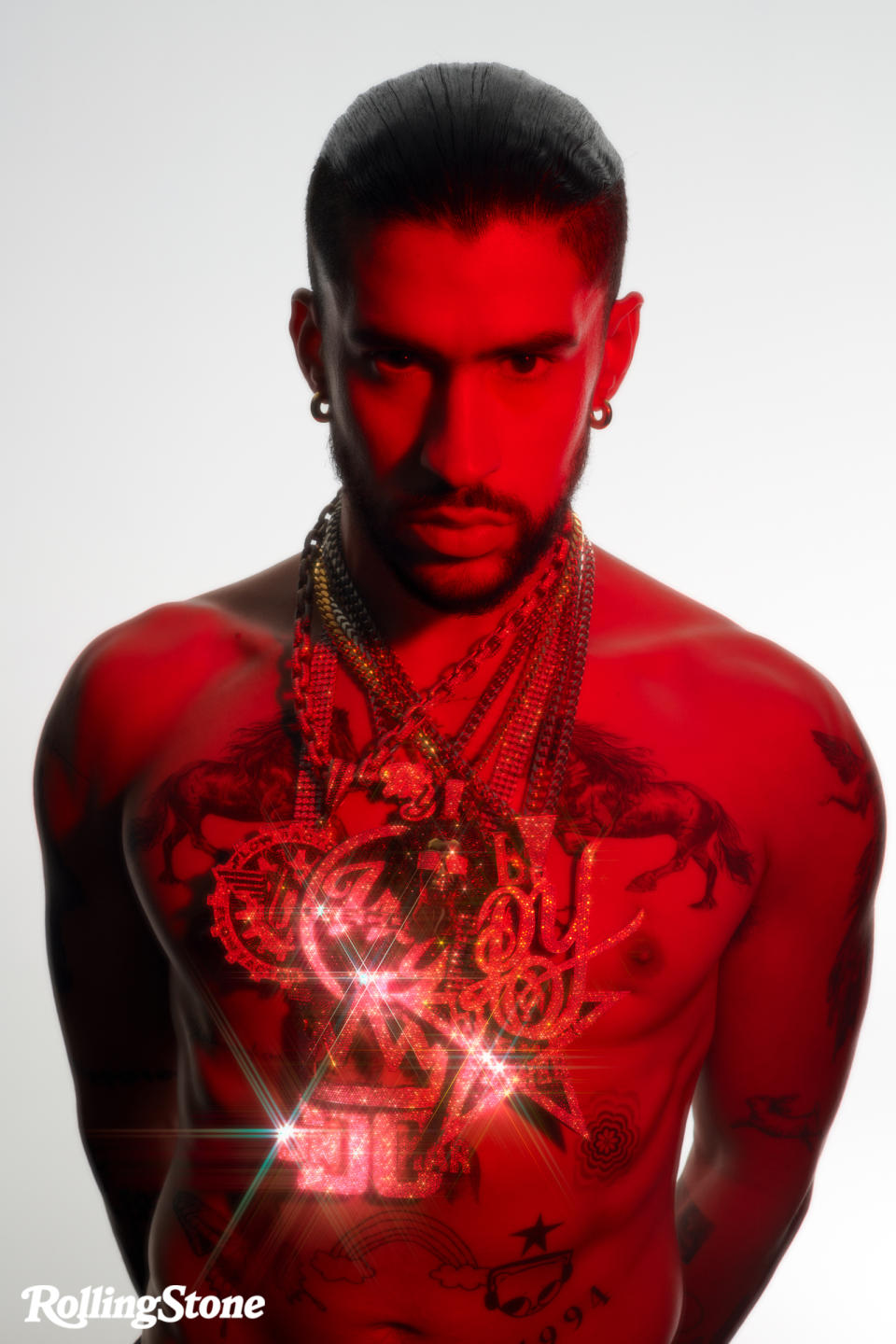
Reggaeton’s Crown Jewels
Bad Bunny always represents where he comes from and the artists who inspired him. For his Rolling Stone cover story, he wanted to honor the reggaeton heroes he looked up to as a kid by wearing jewel-encrusted medallion necklaces with their logos on them. Designed by Avi Davidov and Ofir Ben-Shimon, the medallions represent the decades-long careers of Puerto Rican luminaries Tego Calderón, Héctor El Father, Wisin Y Yandel, Arcángel, Don Omar, and Daddy Yankee. Bad Bunny had been toying with the idea for a long time, thinking he would wear the necklaces to pay homage to the reggaeton greats at a major concert or public appearance. “When the opportunity to shoot with Rolling Stone came along, I was like, ‘Damn, that would be perfect.’ ” He sees himself as part of the lineage of these artists and carrying on their legacy. “That’s my foundation,” he says. “I’ve taken something from all these artists I’ve listened to and loved.”
This kind of narrative was something that Martínez wanted to reverse at Coa-chella. One way to do that, he thought, was to invite Feliciano onstage with him. During the festival’s second weekend, the 77-year-old artist stepped in for an emotional moment, playing the acoustic portion Post Malone had a week before. (Feliciano had better luck with the mics.)
Martínez also included those tribute videos — an entire history lesson folded into the show, paying homage to Cuban salsa legends like Celia Cruz and La Lupe, and reggaeton titans like Tego Calderón and Daddy Yankee, while tracing the Black roots of these genres and the influences across the Caribbean that have shaped them. The approach was similar to another one of Martínez’s interventions on a gate-kept world stage: the Grammys, where, in February, he put distinctly Puerto Rican musical traditions like bomba and plena on display. He ended his show with cabezudos — giant character heads used in festivals and processionals — representing beloved icons from the island, like baseball legend Roberto Clemente, singer and composer -Ismael Rivera, and others.
Martínez’s gestures often culminate in more direct action, too, like when he cut his 2019 tour in Europe short to join Puerto Rico’s protests against then-Gov. Ricardo Rosselló. Last July, he blasted LUMA Energy — the private company that’s mismanaged Puerto Rico’s power grid — and current Gov. Pedro Pierluisi at a show in San Juan: “Pierluisi and all the dick suckers who run Puerto Rico, fuck off.” “He represents different things at different moments, but I think he always represents Puerto Rico,” says Vanessa Díaz, a professor at Loyola Marymount University who teaches a class called “Bad Bunny and Resistance in Puerto Rico.” “I think that he always represents a Puerto Rican spirit of resistance and struggle and the complexity of life there.”
Since he started making music, Martínez has sought to capture the depth of Puerto Rican identity and Caribbean traditions. That might be why it was jarring for some fans when he appeared on the cover of Time in March and discussed “El Apagon,” arguably his most political song since the protests. The title means “The Blackout,” a reference to the power outages that have plagued Puerto Rico since Hurricane Maria, and it celebrates the beauty of the island while calling out gentrification and displacement there. Speaking to Time, Martínez shared that he wrote the song’s line “Ahora todos quieren ser Latino, pero les falta sazon” (“Now everyone wants to be Latino, but they’re missing flavor”) after feeling frustrated with the way certain artists seemed to embrace Latino identity only when it was convenient. But, he added, “Now that feeling has passed me. It’s not like I feel like that right now.”
The quotes ricocheted across social media, where they were translated, mangled, and misinterpreted as Martínez saying he regretted making “El Apagon.” A backlash erupted, one that roughly coincided with paparazzi releasing photos of Martínez and Jenner hanging out. Everyone, it seemed, suddenly had an opinion about Martínez. “Sadly, Bad Bunny has been consumed by the gringo market.… How does he regret writing one of the most iconic lines in ‘El Apagon?’ ” one person wrote on Twitter. -Another went viral with a virulent TikTok speech calling Martínez’s outings with Jenner an example of “the power of a fully colonized mind.”
Martínez seemed to address the furor in an impromptu speech at Coachella: “You won’t get to know the real me through a video on Insta-gram, an interview, or a TikTok. If you really want to get to know me, I invite you to my home.”
When I ask him to clarify what that speech meant, he’s quiet for a second. “It’s a delicate issue,” he says, finally. “That interview was taken out of context, so I’d hate for the same thing to happen with this one. But I’ll try to explain it: What I said was, like, people are funny — it’s funny and also frustrating to see how people really think they know about the lives of celebrities, of what they think, of what they do day to day. They think they know the story of your life, your interior thoughts, your romantic life, but, in reality, they don’t know at all.…
“When I saw [people saying] that I had regretted writing ‘El Apagon,’ it shocked me, like when did I ever say that in the interview? I would never say that in my fucking life,” he continues. It frustrated him because of what the song meant. “It was a whole journey, like the process that began with something patriotic, and then the party and the messing around, and later the sentimental part, the conscience in it. I always say that’s the life of people in Puerto Rico: We’re proud of being Puerto Rican, we love to celebrate and act like nothing matters, and then we clash against a reality that is often very painful.” (I ask him who the infamous “Ahora todos quieren ser Latino” line was about. “Obviously, I’m not going to tell you,” he says, laughing lightly. But he does share that his initial frustration was aimed at two women in particular.)
The place in the Hollywood Hills marks Martínez’s first time living outside of Puerto Rico. “He’s an introvert,” Assad tells me later. “I don’t want to use the word ‘low-key’ because that sounds cliché, but he really is.” Most of his inner circle has been around for years; he and Oliveras went to the same high school, and he’s known his photographer and assistant Jomar Dávila since he was around 11. “To this day, he’s with his eight best friends, and they’re working,” Assad says. “They’re not his entourage, they’re his family.”
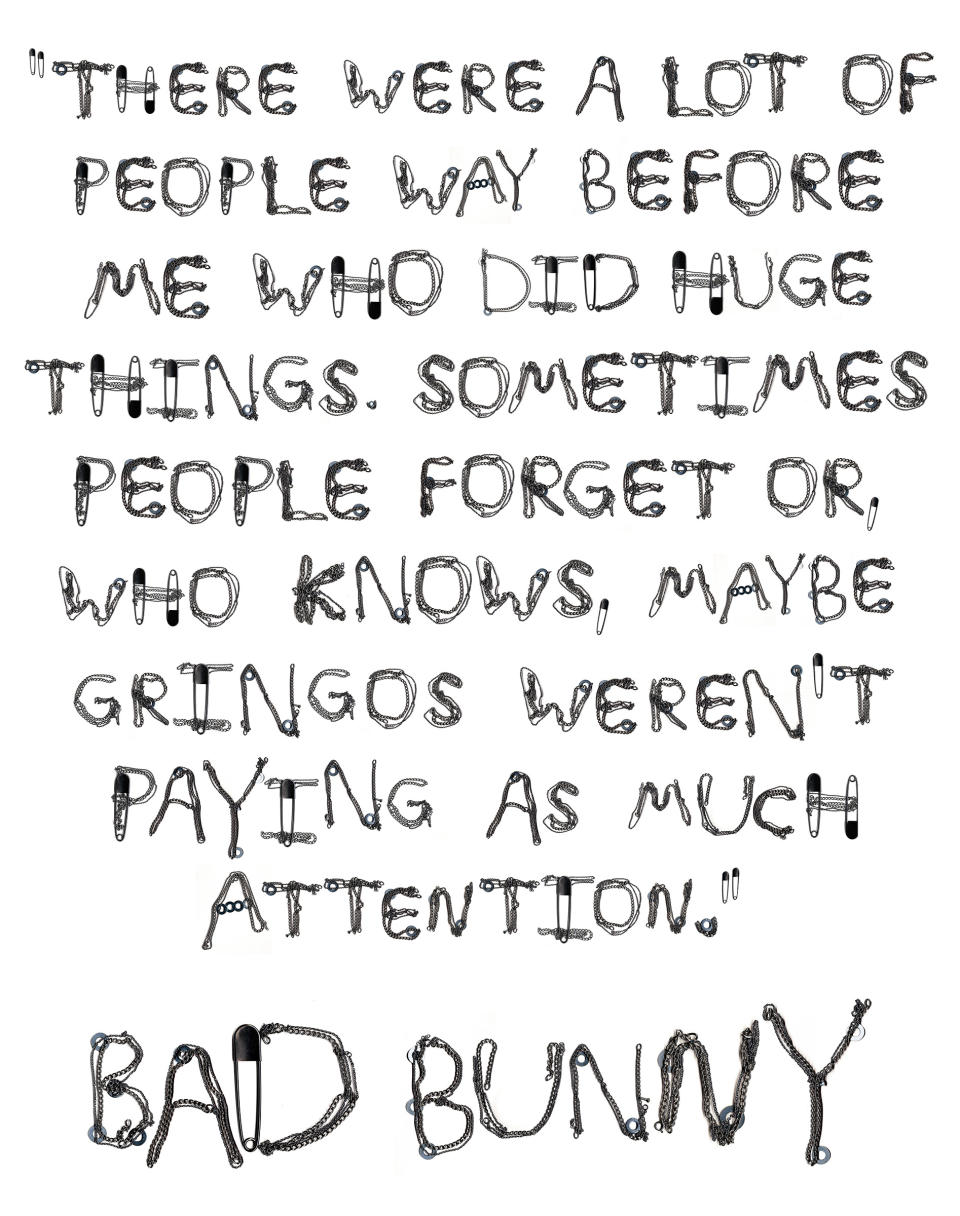
Living in California has let Martínez “experiment with new routines, new places, meeting new people,” as he puts it. L.A. also allows him to move around a little more easily; in Puerto Rico, he tends to cause a scene when he goes out. “I like to go eat at a restaurant calmly, go see a movie, relax, go for a walk,” he says of L.A. But eventually, he’ll go back. “Puerto -Rico’s my home,” he says. “I don’t see myself getting old anywhere other than Puerto Rico.”
For the time being, though, he’s been leaning into his Hollywood era — attending Beyoncé and Jay-Z’s Oscar afterparty, greeting the -Weeknd at Coachella. When I tell him it seems like he’s been expanding his circle of friends in Los Angeles, he’s quiet for a second. “Yeah, I think so. I’ve been a little complicated when it comes to getting to know people my whole life. At school, I was always really close to my friends, and I was friendly, but also closed off. During this time, I’ve been trying to socialize more, get to know more people.”
Even though his outings with some of those friends — Jenner in particular — have become splashy tabloid fodder, there’s a lot he wants to hold for himself. He’s protective about his personal life: “I know something is going to come out. I know [people are] going to say something. People know everything about me, so what’s left for me to protect? My private life, my personal life.” Later, I ask him if he wants to clear up anything about his relationship status and the tabloid rumors with Jenner, and he offers the same refrain: “That’s the only answer. In the end, the only thing I have is my privacy.”
The paparazzi attention doesn’t feel like a big change for him. “Today, everyone’s a paparazzi,” he says. “We’re in the worst time, the worst moment for the privacy of other humans; not just artists, but human beings. Today, no one respects the privacy or life of anyone. There could be someone in line with, I don’t know, weird pants on or something, and someone is there filming them.”
What’s it been like to have people so invested in his personal life? “I keep living,” he says. “Fans are always going to want to know more, but I don’t focus on that. I’m always going to keep living my way.”
About a week after the desert video shoot, Martínez is at New York’s Mark Hotel, meeting with the French designer Simon Porte Jacquemus ahead of the Met Gala. The room is serene — Oliveras puts on a playlist of low-fi bands I’ve never heard of — and Martínez stands in front of the mirror quietly, wearing a pristine white suit with 26 feet of floral fabric trailing behind (Oliveras says the look was inspired by photos of Karl Lagerfeld with his cat, Choupette). Martínez tries on two sets of pants before deciding on a slimmer cut Jacquemus had designed, then turns to reveal a backless blazer, adorned with a silver body chain featuring a “J” charm dangling down his spine.
Martínez’s second appearance at the Met Gala is far less nerve-wracking than his first. “Last year, I felt like I was the new kid in school,” he says when we get back into the car and head to the nearby hotel where he’s staying. “I think this year I’m going to feel a lot more comfortable.” Plus, he enjoys the process of getting ready: “I like dressing pretty.”
His Met Gala outfit reflects the gender--fluid style he’s known for. He’s worn nail polish and bright-pink minidresses over the years, and in 2020, he was fully in drag for his “Yo Perreo Sola” video. His consciousness-raising goes beyond style, too: He’s spoken out about transfemicides and gender violence in Puerto Rico, and last summer, he made headlines for kissing a male dancer onstage during his VMAs performance. GLAAD gave him its 2023 Vanguard Award, which Ricky Martin presented to him while applauding him for encouraging LGBTQ communities to “dance, sing, love, and live lives authentically.”
Back in his hotel room, Martínez walks to a turntable and cues up Fleetwood Mac’s Rumours. I ask him what else he’s been listening to, and he flips through his phone, reading some of his playlists out loud. “I’ve been listening to Luis Miguel a lot,” he says, referring to the famous mariachi and bolero balladeer. He lists off a few more Mexican acts that have been blowing up lately: Grupo Frontera, Peso Pluma, Eslabon Armado. There’s a range of genres, too: “Radiohead,” he says, name-checking albums like OK Computer and In Rainbows. “Phob …” He trips over the name slightly. “Phoebe Bridgers?”
“Whether I’m at home or with the guys, we listen to everything: reggaeton, trap, bachata, salsa, música Mexicana, banda, regional, corridos tumbados,” he says. He sees a newer generation of artists as constant motivators: “I see them tearing it up, and it makes me want to tear it up even harder.”
Some of those newer artists include the guys from Grupo Frontera, who Martínez brought onstage the second week of Coachella to play “un x100to,” a song they’d collaborated on. Martínez helped curate Rolling Stone’s Future 25, a list featuring our favorite artists on the rise, suggesting everyone from the innovative singer--songwriter-violinist Sudan Archives to Puerto Rican acts like trap dynamo Young Miko, trailblazing rapper Villano Antillano, and urbano singer Omar Courtz. He also shouts out Peso Pluma, the breakthrough música Mexicana sensation. -Martinez says that when they met for the first time at Coachella, Peso Pluma immediately apologized for a moment at a recent concert, when he shouted that “Ella Baila Sola,” a song he made with the band Eslabon Armado, had surpassed “el -pendejo de Bad Bunny” (“the ass-hole Bad Bunny”) to reach Number One on Spot-ify.
“I was like ‘You don’t need to say sorry,’ ” Martínez says, laughing. “I said, ‘I remember when I was young, in your position, and would get excited.’ ”
Martínez is still young, but he’s become an outsize figure to other artists, fans, and even academics. As we talk, there’s a two-day symposium coming up called “Thinking with Bad Bunny: Cultural Politics and the Future of Puerto Rico,” organized by the Center for Puerto Rican Studies at Hunter College, with help from Díaz and Wellesley professor Petra Rivera--Rideau. The idea that there’s an entire university event dedicated to his career is a little shocking for him. “I’m like, ‘What in the world?’ I would have liked to take that class in college to get an A,” he jokes.
He’s flattered — but he tries not to get caught up in all the recognition. “I have in the back of my mind that I want to do big things and make a difference, but I do it for myself,” he says. “I don’t do it hoping that at some point, they’ll offer classes about me at universities. I don’t think anyone thinks that way.” He lowers his voice, mimicking what he imagines a pretentious musician to sound like: “One day, I want them to study my work.”
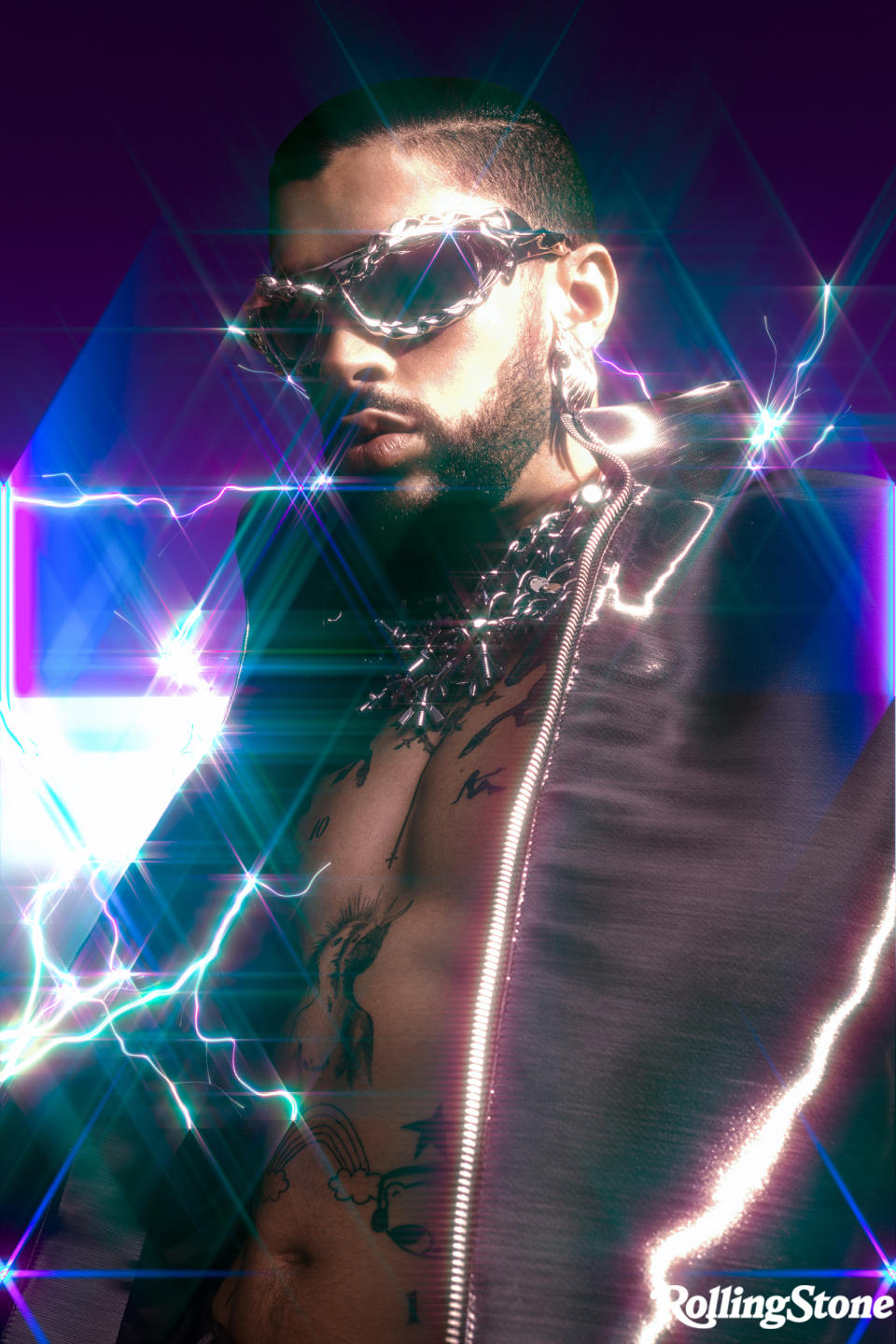
Surely, being a global superstar comes with some pressure? Martínez rejects the question. “If I ever feel pressure, it’s because it’s coming from me. If I want to do something better, it’s because of me. I don’t let myself give into pressure from other people, I don’t feel pressure to be the best. Never, ever, ever. I do this because I love it.”
Yet Martínez’s entire career has positioned him as the most visible Latino in music right now; because of that, the expectations and responsibilities fans place on him only seem to multiply, particularly when it comes to speaking up about political and social issues. “I think that’s where I clash with people,” he says. “Everyone sees life how they want, and everyone can think what they want. I don’t have an obligation to anyone — the slightest obligation to anyone.… I have what I think here,” he says, pointing to his temple. “I can say it to my friends, I can vent to my mom, I can vent talking to myself, but I don’t need to share that with the public. I’m not a -superhero. I’m an artist who’s here to make music because I love making music.”
He sees a lot of artists who make corporate-feeling statements that ring false. “They’ll put up a message that their publicist wrote on social media, and people will applaud it just because they did it to check off a box,” he says. He knows that in some ways, his music and his example might be more effective than any statement he could make.
“I’m not very good at standing in front of people and saying a speech,” he says. “Any time I have to accept an award and say something, it’s, like, the worst time in my life as an artist.… But I think that’s exactly the specific reason that I’m an artist. The way I feel most comfortable saying something is through a song or a video. People who have a talent for talking or speaking for something in society should do it. I feel I did that part with my song.”
But more complex conversations might require more of Martínez, given his position in the industry. One involves colorism and racism in Latin music, forces that mean a white-skinned artist like Martínez can become a superstar while Black Latinos remain largely absent from the highest levels of the music scene. In his Time interview, he was asked whether elements of race and colorism played a role in who succeeds in reggaeton. “Because I haven’t seen it or lived it,” he was quoted as saying. “I can’t say. It’d be irresponsible of me to say yes.”
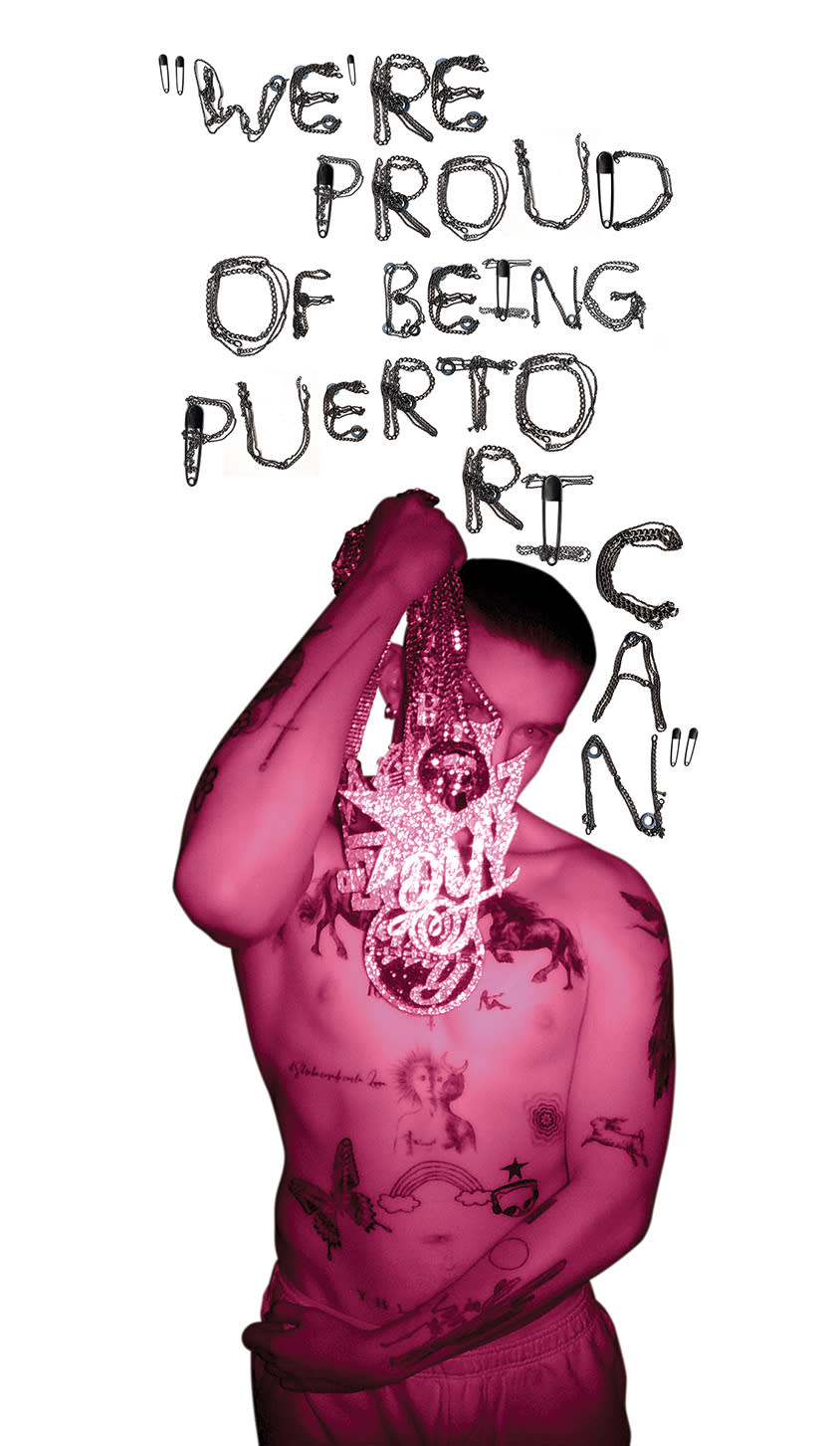
To many, that answer felt dismissive, as if he couldn’t be bothered to notice. When I bring it up, Martínez claims it’s another comment taken out of context. (In his full answer, published in a separate article by the magazine, the quote is part of a longer answer about how his views on the topic had evolved.) To me, he says he didn’t want to speak over the experiences of people who have suffered racism. “I’m Latino, Caribbean, my skin is white,” he explains. “I have felt rejection in the U.S., maybe in some places because of being Latino. I’ve felt rejected in a world where there’s a lot of rich people and you could have 100 million in your bank account, and to them, you’re [looked down on] for being Latino. I can’t speak over the experiences of other artists. It’s obvious that racism, colorism exists in all parts of the world, in all industries.”
He points to his past actions when it comes to bigger conversations like these: “In my songs, in my actions, in my videos, in my everyday living. That’s what I’m referring to: I think my actions and what I do away from the cameras and away from the public eye is worth more than what I say publicly, because at the end of the day, people take words and do what they want with them.”
I catch up with Martínez again by phone in early June. He’s in L.A., having just spent a few weeks traveling — first to Puerto Rico, then to Monaco, where he caught a Formula 1 race, then back to Puerto Rico to decompress. He hung out with his family. He cheered on Los Cangrejeros de Santurce, who’d been enjoying a winning streak. “I was just resting and living. I wasn’t doing anything specific,” he says, sounding like he finally got the time off he’s been looking for.
Meanwhile, his career keeps blowing up. Just after “Where She Goes” came out, Martínez broke a Spotify record for the biggest streaming day for a male artist. The song was featured in his first Pepsi commercial, another celebrity milestone that puts him among the ranks of Britney Spears, Michael Jackson, and fellow Puerto Rican Chayanne, who did the first-ever Pepsi ad in Spanish in 1989. Fans are, again, -divided online: Some balk at the idea of Bad Bunny teaming with a corporation for an ad; others are glad to see him represented in very visible marketing campaigns.
No one is sure what’s coming next. Martínez does confirm that a collaboration with Travis Scott is on the horizon. “We worked on that a while back — and I think Travis has been working on his project for a minute,” he says. Beyond that, he’s trying to take a leisurely approach to music, recording things here and there if they feel right. “I don’t know if maybe I’ll release a song [this year] if I like it enough, but I don’t think so. I said this year was for resting.”
Who knows, though? Martínez has built a career out of unpredictable moves. He could stay quiet the rest of the year; he could release a full album. So much of his appeal is his ability to keep you guessing.
Further down the line, there’s a future only he can see. He says he has years’ worth of projects and material lined up in his head: “I spend so much time thinking about what I’m going to do next, thinking and creating, imagining things.” People might be full of questions, eager to know where his career will take him. Martínez isn’t one of them: “I already know where I’m going.”
Production by hound content. Produced by dionne cochrane; missy galanida; andrea saavedra. Photography direction by emma reeves. Hair by nikki nelms for The Only Agency. Makeup by keita moore for The Only Agency. Set design by griffin stoddard. Set dressers: arlington garrett and ricky torres. Leadman: Henry Culpepper. Carpenter: alec genna. Art coordinator grace beck. Set airbrush artist: patrick quinn. Lighting Director: Byron Nickleberry. Photography assistance: elianel clinton. Digital technician tara chumpelik. Styling assistance brianna dooley, ricardo mcleod, melinda velovic. Hair assistance: ikeyia powell. Makeup assistance: nicole bueno. Production assistance: brittany thompson. Photographed at pier59 studios.
Best of Rolling Stone
Sign up for RollingStone's Newsletter. For the latest news, follow us on Facebook, Twitter, and Instagram.
Solve the daily Crossword

